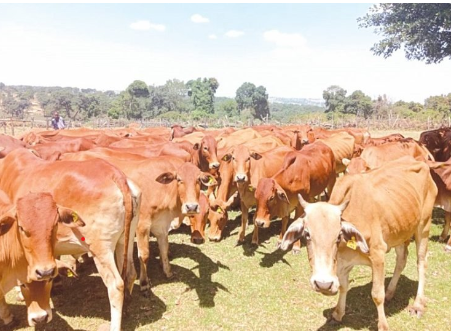In Kenya’s pastoralist communities, where cattle are crucial for survival, Dr. Wyckliff Ngetich, a veterinary surgeon and PhD fellow at the Feed the Future Innovation Lab for Animal Health (AHIL), is leading the fight against East Coast Fever (ECF), a severe tick-borne disease. ECF poses a significant threat to the economic stability of rural households, worsening food insecurity and malnutrition.
Dr. Ngetich has been instrumental in studying the prevalence of ECF, raising awareness about the disease, and promoting preventive and treatment measures in Narok County. Despite the widespread impact of ECF in the region, many farmers have only learned about the disease, its prevention, and treatment through the AHIL project, underscoring the program’s importance.
Although the ECF burden is substantial, Dr. Ngetich, who also lectures at Egerton University, is confident that with immediate and collective efforts, it can be managed. He takes pride in being part of a team that is making a difference.
ECF, often referred to as ‘cattle malaria,’ is spreading rapidly among farming communities. Farmers face immense challenges in keeping their cattle alive, which directly affects their ability to feed themselves and their families. The disease, caused by the protozoan parasite *Theileria parva*, leads to the death of cattle within three weeks of infection due to fluid accumulation in the lungs, known as pulmonary edema.
The disease claims the life of a cow every 30 seconds and threatens over 50 million cattle in central, eastern, and southern Africa. Because ECF impacts the health and nutrition of families, particularly mothers and children, global researchers are working to address both the disease and its broader effects on farmers’ livelihoods.
“We have evidence that the disease is present in Narok South, and we went deeper and found out that almost 30 percent of the cattle population is at risk of getting the disease within their first year of life,” said Dr Ngetich, referring to the AHIL study, which has enrolled 600 households in the expansive Narok South sub-county.
AHIL is being rolled out in 600 households in Narok County, Kenya, aiming to enhance human nutrition, economic welfare, and resilience by addressing cattle health and production challenges in Kenya and the broader East African region.
Dr. Ng’etich explains that East Coast Fever (ECF) is one of the leading causes of cattle deaths in sub-Saharan Africa, with estimates suggesting over one million cows die annually from this severe tick-borne disease. This loss significantly impacts pastoralist communities, leading to the loss of livelihoods, food insecurity, and increased malnutrition risks, particularly among children.
Addressing this issue is crucial and urgent, starting with identifying disease hotspots and understanding its spread. Dr. Ng’etich, as part of the AHIL team, is studying ECF in Narok South, a key pastoralist region in Kenya, which preliminary studies suggest is a hotspot for the disease.
Dr. Ngetich and his team have found that the mortality rate for infected cattle is 44.4 percent, which is notably high for indigenous breeds that are generally more resilient than exotic ones. For exotic cattle breeds, the mortality rate can reach up to 80 percent.
ECF affects over 20 million smallholder livestock farmers across 12 African countries, including Kenya, causing over $300 million in annual economic losses. The actual mortality rate and economic impact could be even higher due to underreporting from isolated livestock farmers.
Dr. Ngetich believes that with significant investment in effective agricultural extension services by county governments, these communities can be better reached. Such services would also raise awareness about disease spread and available preventive measures.
“Because of the awareness we are creating, livestock farmers under this project have gotten to know about the vaccine and are eagerly asking when they will finally access them,” said Dr.Ngetich.



